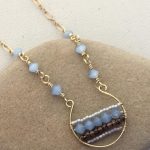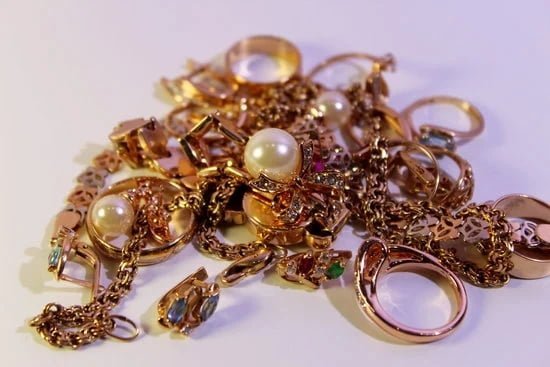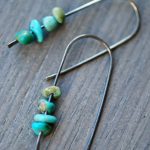If you’re looking for a new and unique way to accessorize your feet, then making beaded foot jewelry may be just the thing for you. With the growing trend and popularity of foot jewelry, it’s no surprise that more and more people are getting creative with their adornments. Beaded foot jewelry offers a truly distinctive and personalized touch, allowing you to express your style and personality in a fun and fashionable way.
One of the great things about beaded foot jewelry is its versatility. Whether it’s a casual beach outing or an elegant evening event, there is always an opportunity to showcase your creativity with these stunning accessories. From simple ankle bracelets to intricate toe rings or barefoot sandals, the possibilities are endless when it comes to designing and crafting your own foot jewelry.
When it comes to creating beaded foot jewelry, understanding the different types of beads available is essential. Seed beads, gemstone beads, glass beads – each offers its own charm and character. In this article, we will explore the various bead options in detail, along with tips on where to find high-quality beads for your projects.
So, if you’re ready to embark on a journey of creativity and self-expression through handmade accessories for your feet, let’s dive into the world of beaded foot jewelry.
Understanding the Different Types of Beads for Foot Jewelry
When it comes to making beaded foot jewelry, choosing the right beads is essential. The type of beads you use can greatly impact the overall look and feel of your design. In this section, we will discuss the different types of beads available for making foot jewelry, including seed beads, gemstone beads, and glass beads.
Seed beads are tiny beads that come in a wide range of colors and finishes. They are often used as spacer beads in foot jewelry designs due to their small size. Seed beads are perfect for adding delicate details or creating intricate patterns. These beads can be made from various materials such as glass, metal, or plastic.
Gemstone beads add a touch of elegance and natural beauty to foot jewelry designs. They come in a variety of shapes and sizes, and each gemstone has its unique properties and meanings. For example, amethyst is believed to promote calmness and balance while turquoise symbolizes protection and good fortune. Incorporating gemstone beads into your foot jewelry can add a meaningful touch.
Glass beads are versatile and come in an array of colors, shapes, and finishes. They can mimic the appearance of precious gemstones or create vibrant pops of color in your designs. Glass beads are also available in different styles such as Czech glass or Murano glass, each offering its own distinct characteristics.
To ensure that your foot jewelry is high-quality and durable, it is important to purchase your beads from reputable sources. There are many online bead stores where you can find a wide selection of high-quality beads ranging from affordable options to more luxurious ones. Some popular bead suppliers include Fire Mountain Gems, Artbeads.com, and Fusion Beads.
In summary, understanding the different types of beads for foot jewelry allows you to make informed decisions when designing your pieces. Whether you choose seed beads for delicate details, gemstone beads for added elegance or glass beads for vibrant colors, your selection will play a pivotal role in the overall aesthetic of your foot jewelry design.
| Type of Beads | Description | Examples |
|---|---|---|
| Seed Beads | Tiny beads available in various colors and finishes. Perfect for intricate patterns. | Glass seed beads, metal seed beads, plastic seed beads |
| Gemstone Beads | Beads made from natural gemstones with unique properties and meanings. | Amethyst, turquoise, rose quartz |
| Glass Beads | Versatile beads that come in a wide range of colors, shapes, and styles. Can mimic precious gemstones. | Czech glass beads, Murano glass beads |
Essential Tools and Materials for Making Beaded Foot Jewelry
To successfully create beautiful beaded foot jewelry, it is important to have the right tools and materials. Having the necessary items on hand will make the process much easier and enjoyable. Here is a list of essential tools and materials for making beaded foot jewelry:
Pliers
Pliers are a must-have tool for any beading project. You’ll need both round nose pliers and chain nose pliers. Round nose pliers are used for creating loops, while chain nose pliers are ideal for gripping and bending wire.
Wire Cutters
Wire cutters are essential for cutting wire to the desired length. It’s important to have a pair of wire cutters specifically designed for jewelry making to ensure clean cuts without damaging the wire or beads.
Needles
Needles are necessary when working with stringing materials like thread or thin wire. Be sure to choose needles that are thin enough to fit through the holes of your beads easily.
String or Wire
The type and thickness of string or wire you use will depend on your design preferences and the durability required for your foot jewelry. For stringing beads, consider using high-quality nylon thread or stretchy cord for elastic bracelets. If you prefer working with wire, choose a gauge that matches the size of your beads and ensures sufficient strength.
Clasps, Charms, and Findings
These additional materials can add a touch of personalization and style to your foot jewelry creations. Clasps come in various designs, such as lobster claw clasps or toggle clasps, which allow you to easily fasten or adjust your jewelry. Charms can be used to represent personal interests or themes in your design, while findings like jump rings help attach them securely.
Ensure that you have all the tools and materials listed above before beginning your beaded foot jewelry project. Ready your workspace and gather the necessary items to ensure a seamless and enjoyable crafting experience. With these essential tools, you’re now ready to dive into the world of beading and create beautiful foot jewelry that reflects your unique style.
Step-by-Step Guide
Creating a simple beaded ankle bracelet is a great way to start your journey into making beaded foot jewelry. In this section, we will provide a step-by-step guide that even beginners can follow. By following these instructions, you’ll have a beautiful ankle bracelet in no time.
Gather Your Materials
Before you begin creating your ankle bracelet, make sure you have all the necessary materials. You will need:
- Beads of your choice: Choose beads that are suitable for foot jewelry and align with your desired design. Seed beads or small gemstone beads work well for this project.
- String or wire: Select an appropriate string or wire based on the type of beads you are using. A nylon thread or thin beading wire is usually recommended.
- Clasp: Choose a clasp that is easy to fasten and secure on your ankle.
- Jump rings and crimp beads (optional): These can be used to attach the clasp to the string or wire.
Step-by-Step Instructions
- Measure your ankle: Use a flexible measuring tape to determine the circumference of your ankle.
- Cut the string or wire: Cut a length of string or wire that is approximately 2 inches longer than your ankle measurement.
- Attach the clasp: If using jump rings and crimp beads, slide one jump ring onto each end of the string or wire, followed by a crimp bead on each end. Loop one end of the string or wire through one side of the clasp and back through the crimp bead. Use pliers to flatten the crimp bead, securing it in place.
- Stringing the beads: Begin by selecting your first bead and threading it onto the string or wire, sliding it toward the clasp end. Continue adding beads until you reach about half an inch from reaching your desired length.
- Creating a loop: To create a loop for attaching the clasp, thread the string or wire through a crimp bead and back through the last few beads. Slide the crimp bead close to the last bead and use pliers to flatten it.
- Attach the other side of the clasp: Slide one jump ring onto the string or wire, followed by the other side of the clasp. Loop the string or wire through a crimp bead and back through the last few beads. Use pliers to flatten the crimp bead.
- Trim excess string or wire: Cut any excess string or wire, making sure to leave a small length for security.
Tips and Tricks
- Experiment with different bead sizes, colors, and patterns to customize your ankle bracelet.
- Consider adding charms or pendant drops for extra flair.
- If using seed beads, consider using a beading needle to make it easier to thread them onto your string or wire.
Remember, practice makes perfect. Don’t be discouraged if your first attempt is not exactly as you imagined. With each project, you’ll improve your skills and develop your own unique style in creating beaded foot jewelry.
Adding Personalized Touches
Incorporating charms and pendants into your beaded foot jewelry can add a personalized touch that reflects your unique personality or interests. Charms and pendants come in a wide variety of shapes and designs, making it easy to find the perfect ones for your foot jewelry creations. By incorporating these decorative elements, you can elevate your designs and create pieces that truly stand out.
One popular way to attach charms or pendants to your foot jewelry is by using jump rings. Jump rings are small metal rings that can be easily opened and closed with pliers. To attach a charm or pendant, simply slide the jump ring through a loop in the charm or pendant, and then attach the ring to your beaded piece by sliding it onto the string or wire.
Another technique for attaching charms or pendants is wire wrapping. This technique involves creating a small loop at one end of a piece of wire, threading the charm or pendant onto the wire, and then creating another loop at the opposite end of the wire to secure it in place. Wire wrapping gives you more control over how the charm or pendant hangs on your foot jewelry, allowing you to achieve different looks and styles.
When incorporating charms and pendants into your designs, consider using themed pieces that match your overall design concept. For example, if you’re creating a beach-inspired foot jewelry piece, you could use seashell charms or starfish pendants. If you prefer a bohemian style, choose charms with feathers or dreamcatcher designs. The possibilities are endless when it comes to adding personalized touches to your foot jewelry.
To give you some inspiration for incorporating charms and pendants into your beaded foot jewelry designs, here are some ideas:
- Use birthstone charms for a personal touch.
- Attach initial pendants to create monogrammed foot jewelry.
- Incorporate nature-inspired charms like leaves or flowers.
- Mix different types of metal charms for an eclectic look.
- Combine charms with other elements like beads or chains for added dimension.
By adding charms and pendants to your beaded foot jewelry, you can take your designs to the next level and create pieces that truly speak to your individual style. The possibilities are endless, so let your creativity shine and have fun experimenting with different combinations of beads, charms, and pendants.
| Technique | Description |
|---|---|
| Jump Rings | Small metal rings that can be easily opened and closed with pliers for attaching charms or pendants. |
| Wire Wrapping | A technique where a small loop is created at each end of a wire to attach a charm or pendant securely. |
| Bead Embellishment | Add beads around a charm or pendant using techniques like bead weaving or bead embroidery to create intricate designs. |
Advanced Techniques
The world of beaded foot jewelry offers endless possibilities for creativity and personal expression. Once you have mastered the basics of making simple ankle bracelets, it’s time to take your skills to the next level with advanced techniques like peyote stitch or netting. These techniques can be used to create intricate designs that are sure to make a statement.
One advanced technique you can explore is peyote stitch. Peyote stitch involves weaving beads together in a patterned, off-loom technique. To create foot jewelry using this technique, you will need seed beads and a beading needle. Start by threading your needle with the desired color of bead and string on enough beads to fit around your ankle or foot comfortably.
Once you have your first row of beads in place, you can start weaving in subsequent rows to create your design. The key to successful peyote stitch is keeping a consistent tension as you add each bead. This will ensure that the final piece is sturdy and well-formed. Many resources and tutorials are available online that offer step-by-step instructions for various peyote stitch patterns.
Another advanced technique to explore is netting. Netting involves creating an openwork pattern by weaving threads between rows of beads. This technique adds texture and dimension to your foot jewelry designs. To get started with netting, you will need seed beads, beading thread or fishing line, and a beading needle.
To begin, string on an even number of beads for the first row and create a base row by stitching through each bead multiple times to secure them in place. From there, you can start adding additional rows by weaving thread back and forth through the base row. Experiment with different bead placements and patterns to achieve unique effects.
Mastering these advanced techniques may take practice and patience, but the results are sure to be worth it. By incorporating peyote stitch or netting into your foot jewelry designs, you can elevate your creations to the next level of artistry. With these techniques in your repertoire, the possibilities for creating one-of-a-kind foot jewelry are truly endless.
Troubleshooting Common Issues in Beaded Foot Jewelry Making
Making beaded foot jewelry can be a fun and rewarding craft, but like any creative endeavor, it comes with its own set of challenges. In this section, we will address some common issues that beginners might encounter when making beaded foot jewelry and provide helpful troubleshooting tips to overcome them.
One of the most frustrating problems novice jewelry makers may face is beads breaking during the creation process. To prevent this from happening, ensure that you are using beads made from durable materials such as glass or gemstones. Certain types of beads, like crystals or delicate seed beads, are more prone to breakage and should be handled with extra care.
Additionally, consider using a nylon-coated wire or a strong beading thread to string your beads. The added strength and flexibility of these materials can help reduce breakage.
Another issue that may arise is strings unraveling after completing a piece of foot jewelry. To avoid this problem, reinforce your knots by adding a dab of clear-drying glue or using a crimp bead at the end of the string or wire. This helps secure the knots in place and prevents them from slipping undone. It’s also important to ensure that you have enough string or wire when starting your project to avoid running out halfway through.
Sometimes, you may notice loose or uneven beads in your finished foot jewelry piece. To fix this issue, gently adjust the position of the beads with your fingers until they sit evenly along the string or wire. If certain beads refuse to cooperate, you can use a drop of jeweler’s glue between them to hold them in place securely.
If you encounter flawed pieces during the crafting process, don’t despair. Instead of discarding them as wasted efforts, consider repurposing them into other jewelry items such as bracelets or earrings. This not only reduces waste but also gives you an opportunity to explore different designs and techniques.
By addressing these common issues in beaded foot jewelry making and offering practical solutions, you can overcome hurdles and continue enjoying the creative process. Remember, practice makes perfect, so don’t be discouraged if you encounter setbacks along the way. With time and experience, you’ll become more skilled at troubleshooting and creating beautiful foot jewelry pieces.
Inspiring Foot Jewelry Designs and Styling Tips
Foot jewelry is not only a unique accessory but also a form of self-expression that allows you to showcase your personal style. With endless possibilities for creativity, designing and creating your own beaded foot jewelry can be an exciting and fulfilling experience. In this section, we will explore some inspiring foot jewelry designs and offer styling tips to help you make a statement with your creations.
When it comes to designing foot jewelry, the options are truly limitless. Whether you prefer delicate and dainty designs or bold and whimsical pieces, there is something for everyone. Consider incorporating different colors, textures, and bead sizes to add depth and visual interest to your foot jewelry.
For a beach-inspired look, mix shades of blue and green beads with seashell charms or pearl accents. If you’re more inclined towards bohemian styles, opt for earthy tones like brown, bronze, or turquoise with feather or dreamcatcher charms.
Styling your foot jewelry appropriately can elevate your outfit and complete the overall look. One key aspect to consider is the type of footwear you’ll be wearing. For sandals or flip-flops, anklets or toe rings are ideal choices as they draw attention to those areas.
Match the colors of your foot jewelry with the straps or embellishments on your shoes for a cohesive aesthetic. If you’re wearing closed-toe shoes or heels, opt for ankle bracelets that peek out subtly.
Layering foot jewelry creates a trendy and fashionable statement. Experiment by combining different styles, lengths, and textures to create a stacked effect on your feet. For example, layer an anklet with a toe ring or stack multiple ankle bracelets for an eye-catching look. Mixing metals like gold and silver can add further dimensionality.
To complete your overall look seamlessly, don’t forget about coordinating other pieces of jewelry such as necklaces or bracelets with similar bead colors or motifs found in your foot jewelry. This will create a cohesive and polished appearance.
Creating beaded foot jewelry not only lets your creative juices flow but also provides you with unique designs that perfectly represent your style. With the inspiration and tips provided in this section, you are well on your way to creating stunning foot jewelry and making a fashion statement with every step you take. Remember to let your imagination run wild, experiment with different bead combinations, and most importantly, have fun during the process.
Conclusion
In conclusion, making beaded foot jewelry is a wonderful way to embrace your creativity and add a unique touch to your style. Throughout this article, we have explored the growing trend of foot jewelry and highlighted the various occasions where it can be worn. We have also discussed the different types of beads available for creating foot jewelry and provided tips on where to purchase high-quality materials.
Additionally, we have covered the essential tools and materials needed for beaded foot jewelry making, as well as provided a step-by-step guide for creating a simple ankle bracelet. We have encouraged readers to personalize their designs by incorporating charms and pendants, showcasing various techniques for adding these elements.
Furthermore, we introduced advanced techniques like peyote stitch or netting for those who want to take their beading skills to the next level. We also addressed common issues that beginners may encounter in the process and offered troubleshooting tips.
Lastly, we shared inspiring foot jewelry designs and styling tips, demonstrating how this accessory can complement different footwear styles and create a cohesive look. Ultimately, we encourage you to let your creativity shine with handmade beaded foot jewelry. Embrace your unique style, experiment with different bead combinations, techniques, and designs. Don’t forget to share your creations with others using a specific hashtag or joining a supportive beading community. Happy crafting.
Frequently Asked Questions
How do you make a beaded foot thong?
Making a beaded foot thong involves a few key steps. First, gather the necessary materials such as beads, elastic cord, and a clasp. Decide on the design and pattern you want for your foot thong and start by threading the beads onto the elastic cord in the desired arrangement. Be sure to leave sufficient length at both ends for attaching the clasp later on.
Once all the beads are in place, finalize the design and secure them by tying knots on either side of each bead. Next, attach the clasp at one end of the foot thong by knotting the elastic cord around it securely. Finally, measure your foot and trim any excess length of cord before attaching another clasp at that end using the same technique. Once completed, your beaded foot thong is ready to wear.
What are foot necklaces called?
Foot necklaces are commonly referred to as anklets or ankle bracelets. These accessories have adorned ankles across different cultures throughout history, known by various names including paayal in India or jinglers in Egypt.
Anklets come in a range of styles and designs, from delicate chains with small charms to more elaborate pieces featuring gemstones or intricate patterns. Regardless of their name or style, ankle bracelets serve as decorative jewelry worn around the ankle, accentuating one’s feet and adding an elegant touch to any outfit.
How do you wear foot jewelry?
Wearing foot jewelry largely depends on personal preference and style choices. One common way to wear foot jewelry is by slipping an anklet or ankle bracelet around your ankle, allowing it to dangle slightly above your feet. This can beautifully complement various types of footwear such as sandals, flip-flops, or even bare feet if you prefer going without shoes.
You can also choose to wear foot jewelry as part of a larger ensemble or when dressing up for special occasions such as beach weddings or summer parties where it adds a fashionable and bohemian flair to your overall look. Ultimately, how you wear foot jewelry is entirely up to you and the statement you wish to make with your accessories.

Welcome to my jewelry blog! My name is Sarah and I am the owner of this blog.
I love making jewelry and sharing my creations with others.
So whether you’re someone who loves wearing jewelry yourself or simply enjoys learning about it, be sure to check out my blog for insightful posts on everything related to this exciting topic!





